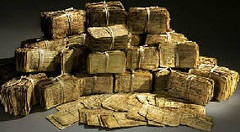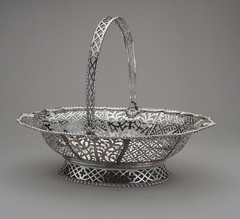
PREV ARTICLE
NEXT ARTICLE
FULL ISSUE
PREV FULL ISSUE
EXHIBIT: MONEY & MEDALS FROM THE COLONIAL WILLIAMSBURG COLLECTION
Erik Goldstein, curator of Mechanical Arts and Numismatics at the Colonial Williamsburg Foundation forwarded this press release about their new exhibit featuring the Cornell hoard of colonial currency discussed in earlier E-Sylum issues.
-Editor
“Dollars, Farthings & Fables; Money & Medals From the Colonial Williamsburg Collection” opens Thanksgiving Day, Thursday, Nov. 25 at the DeWitt Wallace Decorative Arts Museum and explores facts and falsehoods, realities and rumors associated with money including the Founding Fathers and the origins of the dollar. “Many people collect coins as tangible links to distant times and places,” said Erik Goldstein, curator of mechanical arts and numismatics. “Our collection spans 1,000 years, providing period images of a wide array of people, places and things. Within it, there are datable depictions of famous people, art, architecture, nature, industry, historical events, and even patriotic and moral symbols.”


The exhibition contains examples of the extremes in money circulating in colonial and Revolutionary America: the largest coin — an 18th-century French ecu nearly two inches in diameter — to the smallest — a 17th-century English halfpenny; from the largest denomination — an 18th-century Brazilian gold coin worth 20,000 reis — to the smallest denomination — an English farthing worth one-quarter penny; from the prettiest coin — a 17th-century Dutch ducaton — to the ugliest — a 17th-century Bolivian “cob” coin worth four reales. Several firsts in American paper money populate the exhibition. The first “greenback” is a £6 note issued in 1757 by the New Jersey colony. It was the first bill to sport a back side printed in green ink. The first one dollar bill appears as a 1767 issue in the Maryland colony, and first $100 bill was issued in 1779 by the independent state of South Carolina. The exhibition also lays to rest several popular myths about money including the real price the Dutch paid for the island of Manhattan in 1626, the real truth about George Washington's famous coin toss and a popular myth about coins that protected the holder from witchcraft. “Dollars, Farthings & Fables; Money & Medals From the Colonial Williamsburg Collection” is the fifth new exhibition opening during the DeWitt Wallace Decorative Arts Museum's silver anniversary year and will remain on view through December 2012. Admission is by Colonial Williamsburg admission ticket, Museums ticket or Good Neighbor Card. Erik Goldstein adds: The notes remained with the Cornell family until 1913 when they went to the New York Public Library. They were then sold to a dealer (I believe it was Dick Picker) in the 1970s. I believe all the other notes are now scattered to the far corners of the globe! Kay O. Freeman adds:
To read the earlier E-Sylum article, see:
MORE ON THE NORTH CAROLINA COLONIAL CURRENCY HOARD
(www.coinbooks.org/esylum_v13n46a08.html)
The Numismatic Bibliomania Society is a non-profit organization promoting numismatic literature. See our web site at coinbooks.org. To submit items for publication in The E-Sylum, write to the Editor at this address: whomren@gmail.com To subscribe go to: https://my.binhost.com/lists/listinfo/esylum All Rights Reserved. NBS Home Page Contact the NBS webmaster 
|

